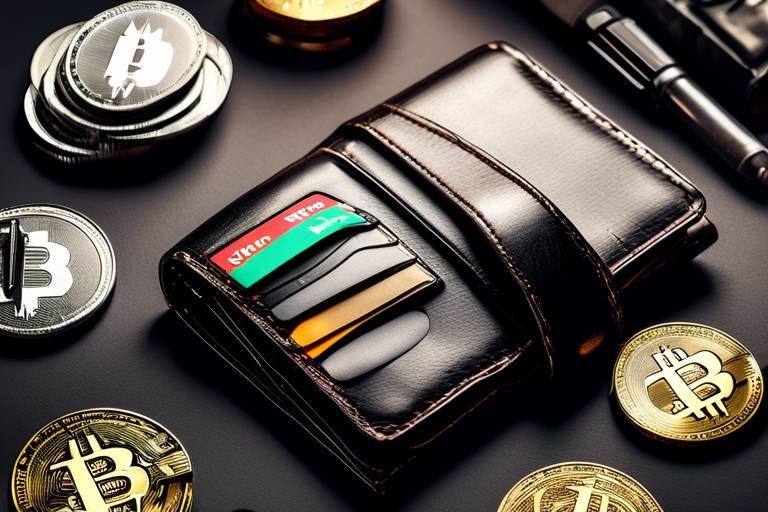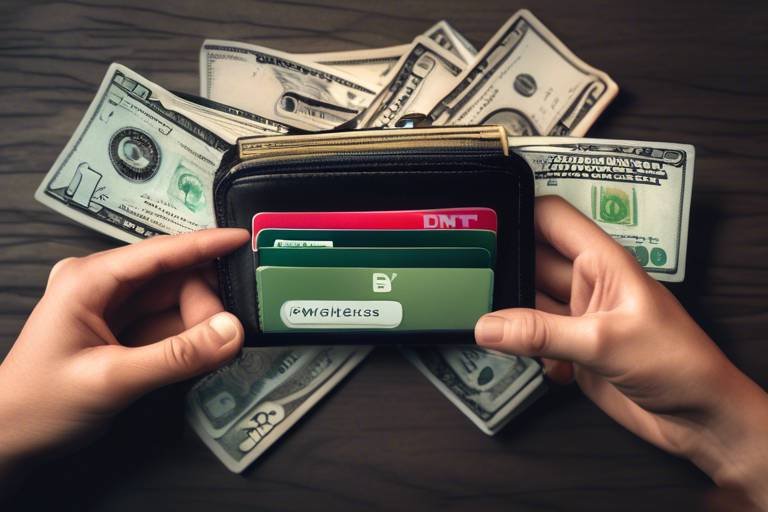The Role of Wallets in Promoting Blockchain Literacy
The digital age has ushered in a myriad of innovations, with blockchain technology standing out as one of the most transformative. But here’s the kicker: understanding blockchain can feel like trying to decipher a foreign language. This is where digital wallets come into play. They are not just tools for holding cryptocurrencies; they are the key to unlocking the mysteries of blockchain technology. By using wallets, individuals can dive deeper into the world of blockchain, enhancing their literacy while engaging with the ecosystem in a hands-on manner. So, how do these wallets contribute to our understanding? Let’s explore!
At their core, digital wallets are like your personal vaults for cryptocurrencies. They allow users to store, send, and receive various digital currencies, acting as gateways to the blockchain universe. Imagine trying to access a treasure chest without the right key—this is how it feels for those without a digital wallet. But it’s not just about storage; it’s about interaction. Digital wallets come in various forms, each offering unique functionalities that cater to different user needs. Understanding these types is crucial for anyone looking to grasp the fundamentals of blockchain literacy.
Think of digital wallets as your personal blockchain classrooms. They provide a practical way to learn about how transactions work, the importance of security, and the overall mechanics of blockchain technology. By engaging with a wallet, users can witness firsthand how digital currencies flow from one account to another. This hands-on experience is invaluable, as it transforms abstract concepts into tangible actions. When users send or receive cryptocurrencies, they are not just participating in a transaction; they are learning about blockchain in real-time.
When it comes to digital wallets, there are three main types that users should be familiar with: hardware wallets, software wallets, and paper wallets. Each type carries its own set of benefits and drawbacks, influencing how users interact with blockchain technology.
Hardware wallets are like the Fort Knox of digital currency storage. They provide a secure method for storing cryptocurrencies offline, making them less vulnerable to hacks and cyber threats. By using a hardware wallet, users can gain a deeper understanding of blockchain security, learning the importance of safeguarding their digital assets. These wallets often come with advanced security features, such as two-factor authentication and encryption, which can educate users on the best practices for keeping their cryptocurrencies safe.
On the flip side, software wallets are more accessible and user-friendly, making them ideal for beginners. They can be downloaded as mobile apps or desktop applications, allowing users to manage their cryptocurrencies with ease. These wallets often come with features that help users understand transaction fees, balances, and even the implications of their transactions on the blockchain. For someone just starting out, software wallets can serve as a gentle introduction to the world of digital currencies.
Using digital wallets also raises awareness about the security measures necessary for protecting digital assets. As users navigate through wallets, they encounter various security protocols, such as private keys and recovery phrases. Understanding these elements is crucial for fostering blockchain literacy. After all, what good is knowledge if it’s not protected? By becoming familiar with these security measures, users can better appreciate the importance of safeguarding their digital wealth.
Wallets do more than just store cryptocurrencies; they encourage active participation in the blockchain ecosystem. When users engage in transactions, they are not only utilizing their wallets but also immersing themselves in the blockchain experience. This active participation leads to greater literacy among users, as they learn about the mechanics of blockchain through real-world applications.
Engaging in transactions through wallets provides practical experience that is essential for understanding blockchain mechanics. Each transaction is a learning opportunity, offering insights into how blockchain operates. Users can see how transactions are confirmed, how fees are calculated, and what happens when a transaction fails. This real-world experience is invaluable, making the abstract concepts of blockchain much more relatable.
Moreover, wallets often connect users to communities and support networks, fostering collaboration and knowledge sharing. These communities provide a platform for users to ask questions, share experiences, and learn from each other. The collective knowledge within these communities can significantly enhance blockchain literacy, as users benefit from diverse perspectives and insights.
- What is a digital wallet? A digital wallet is a software application that allows users to store, send, and receive cryptocurrencies.
- Are hardware wallets safe? Yes, hardware wallets are considered one of the safest options for storing cryptocurrencies as they keep your private keys offline.
- How do software wallets work? Software wallets are applications that connect to the blockchain, allowing users to manage their digital currencies easily.
- What should I consider when choosing a wallet? Consider factors such as security features, ease of use, and whether you prefer online or offline storage.

Understanding Digital Wallets
Digital wallets are more than just a trendy tool in the world of cryptocurrencies; they are the gateways to understanding and interacting with blockchain technology. Imagine walking into a bustling marketplace where every stall represents a different cryptocurrency. Your digital wallet is like your shopping bag, allowing you to store, send, and receive various currencies as you navigate this vibrant ecosystem. But what exactly are these wallets, and how do they enhance our understanding of blockchain?
At their core, digital wallets are software applications or hardware devices that allow users to manage their cryptocurrencies. They come in various forms, each with unique features and security measures. For instance, some wallets are designed for everyday use, while others prioritize security for long-term storage. Understanding these different types is crucial for anyone looking to dive deeper into the world of blockchain.
There are primarily three types of digital wallets: hardware wallets, software wallets, and paper wallets. Each type serves a specific purpose and caters to different user needs.
| Type of Wallet | Security Level | Usability |
|---|---|---|
| Hardware Wallets | High | Moderate |
| Software Wallets | Medium | High |
| Paper Wallets | High | Low |
When users engage with these wallets, they not only learn how to manage their digital assets but also gain insights into the underlying blockchain technology. For instance, by sending or receiving cryptocurrencies, users become familiar with transaction processes, gas fees, and the concept of public and private keys. It's like learning to ride a bike; you can read all about it, but until you actually hop on and pedal, you won't truly understand how it works.
Moreover, the importance of digital wallets extends beyond mere transactions. They serve as crucial educational tools that promote blockchain literacy. By interacting with wallets, users become more aware of the security measures necessary to protect their digital assets. This awareness is vital in a space where scams and security breaches are not uncommon. Just as you wouldn’t leave your house unlocked, understanding how to secure your wallet is key to keeping your investments safe.
In conclusion, digital wallets are essential for anyone looking to engage with blockchain technology. They provide a practical way to learn about cryptocurrencies while fostering a deeper understanding of the mechanics behind blockchain transactions. So, whether you're a seasoned investor or a curious newcomer, embracing digital wallets is a step towards enhancing your blockchain literacy.

Wallets as Educational Tools
In the rapidly evolving landscape of blockchain technology, digital wallets serve not just as storage solutions for cryptocurrencies, but also as powerful educational tools that enhance user comprehension of the underlying principles of blockchain. By engaging with wallets, users gain practical experience that demystifies the complexities of blockchain transactions, security protocols, and asset management. It's akin to learning to ride a bike; you can read all about it, but until you actually get on and pedal, the experience remains abstract.
When users interact with their wallets, they are not only executing transactions but also learning by doing. Each action—whether it’s sending or receiving cryptocurrency—offers a hands-on opportunity to understand how blockchain works. For instance, when a user initiates a transaction, they must consider factors such as transaction fees, network congestion, and confirmation times. This real-world engagement reinforces theoretical knowledge, making blockchain concepts more tangible and relatable.
Moreover, many wallets come equipped with educational resources and features that guide users through their blockchain journey. For example, some wallets include tutorials or tips that explain the significance of various blockchain components, such as public and private keys, smart contracts, and decentralized applications. These built-in educational tools can significantly enhance a user's understanding and confidence in navigating the blockchain landscape.
Additionally, wallets often provide access to a wealth of information regarding current market trends and cryptocurrency valuations. By observing these dynamics, users can develop a more nuanced understanding of how market forces influence blockchain technology. This aspect is crucial because it helps users recognize the broader context in which their digital assets operate, fostering a more comprehensive grasp of the blockchain ecosystem.
In essence, digital wallets serve as a bridge between theoretical knowledge and practical application. They empower users to take control of their digital assets while simultaneously educating them about the intricacies of blockchain technology. As users become more adept at using their wallets, they naturally become more engaged with the blockchain community, further enhancing their literacy and understanding.
To summarize, wallets are not just tools for managing cryptocurrencies; they are essential educational resources that facilitate hands-on learning and promote a deeper understanding of blockchain technology. By leveraging these tools, users can transform from passive observers into active participants in the blockchain revolution.

Types of Wallets
When diving into the world of blockchain, understanding the various types of wallets is crucial. Wallets are not just storage spaces; they are essential tools that facilitate transactions and enhance blockchain literacy. There are three primary categories of wallets: hardware wallets, software wallets, and paper wallets. Each type comes with its own set of features, advantages, and potential drawbacks that cater to different user needs and levels of expertise.
Hardware wallets are often regarded as the gold standard for security. These physical devices store your private keys offline, making them less susceptible to hacking attempts and malware. Imagine keeping your valuables in a safe rather than under your mattress; that's the level of security hardware wallets provide. They are particularly beneficial for users who hold significant amounts of cryptocurrency and prioritize security over convenience. However, they can be a bit more complex to set up and use, which might deter beginners.
On the other hand, software wallets are more accessible and user-friendly, making them a popular choice for newcomers to the blockchain space. These wallets come in various forms, including mobile apps, desktop applications, and web-based platforms. Software wallets allow users to quickly send and receive cryptocurrencies with just a few clicks, akin to using a mobile banking app. While they offer convenience, they are generally less secure than hardware wallets because they are connected to the internet. Users must remain vigilant about security practices, such as enabling two-factor authentication and being cautious of phishing attempts.
Lastly, we have paper wallets, which are perhaps the most straightforward yet often overlooked option. A paper wallet is simply a physical printout of your public and private keys. This method can be incredibly secure if generated and stored correctly, as it is completely offline. However, the risk lies in the physicality of the wallet; if you lose it or it gets damaged, you could lose access to your funds permanently. Paper wallets are best suited for long-term storage rather than daily transactions.
| Type of Wallet | Security Level | Usability | Best For |
|---|---|---|---|
| Hardware Wallet | High | Moderate | Long-term holders |
| Software Wallet | Moderate | High | Active traders and beginners |
| Paper Wallet | High | Low | Long-term storage |
In summary, the type of wallet you choose plays a significant role in your overall blockchain experience. Whether you prioritize security, convenience, or a balance of both, understanding these options will empower you to make informed decisions. Each wallet type offers unique learning opportunities that can deepen your understanding of blockchain technology, making your journey into the crypto world all the more enriching.

Hardware Wallets
When diving into the world of cryptocurrencies, one of the first things you’ll hear about is the importance of security. Hardware wallets are often touted as the gold standard for storing digital assets safely. But what exactly are they, and why are they so crucial for anyone looking to navigate the blockchain landscape?
At their core, hardware wallets are physical devices designed to securely store your cryptocurrency private keys offline. This means that your keys are kept away from potential online threats, making it significantly harder for hackers to access your funds. Think of a hardware wallet as a safe deposit box for your digital currency—it's a secure place where you can keep your valuables protected from prying eyes.
One of the standout features of hardware wallets is their ability to provide a high level of security without sacrificing usability. Most hardware wallets come with user-friendly interfaces and straightforward setup processes, making them accessible even for those who are new to the blockchain world. When you first set up a hardware wallet, you’ll typically go through a series of steps that involve creating a secure PIN and backing up your recovery phrase. This recovery phrase is crucial; it’s your lifeline to access your funds if you ever lose your device.
In addition to their practical security features, hardware wallets also serve an educational purpose. By using a hardware wallet, users gain hands-on experience with blockchain technology. They learn how transactions work, the importance of private keys, and the implications of security in the digital currency realm. This experiential learning can be invaluable, as it transforms abstract concepts into tangible actions. Users often find themselves more engaged and informed about the blockchain ecosystem as they interact with their wallets.
Let’s take a look at some of the most popular hardware wallets available today:
| Wallet Name | Key Features | Price Range |
|---|---|---|
| Ledger Nano S | Compact, supports over 1,500 cryptocurrencies, secure chip | $59 - $79 |
| Trezor Model One | User-friendly interface, supports numerous coins, password manager | $55 - $70 |
| Ledger Nano X | Bluetooth enabled, supports over 1,800 cryptocurrencies, larger storage | $149 - $199 |
In summary, hardware wallets not only enhance the security of your digital assets but also play a pivotal role in fostering a deeper understanding of blockchain technology. By engaging with these devices, users can demystify the complexities of cryptocurrency transactions and develop a more profound appreciation for the importance of security in the digital age.
- What is a hardware wallet? A hardware wallet is a physical device that securely stores your cryptocurrency private keys offline, protecting them from online threats.
- Are hardware wallets safe? Yes, hardware wallets are considered one of the safest ways to store cryptocurrencies due to their offline storage capabilities.
- Can I use a hardware wallet for all cryptocurrencies? Most hardware wallets support a wide range of cryptocurrencies, but it's essential to check compatibility before purchasing.
- What happens if I lose my hardware wallet? If you have backed up your recovery phrase, you can restore your wallet and access your funds even if you lose the device.

Software Wallets
When it comes to diving into the world of cryptocurrencies, are often the first stepping stone for many users. These wallets are applications that can be installed on your computer or mobile device, and they allow you to manage your digital assets with ease. The beauty of software wallets lies in their accessibility and user-friendliness, making them a popular choice for both newcomers and seasoned users alike. Imagine them as your digital purse or wallet, where you can easily store, send, and receive various cryptocurrencies without the hassle of complicated processes.
One of the key advantages of software wallets is their convenience. Users can access their funds anywhere, anytime, as long as they have an internet connection. This flexibility is particularly appealing in a fast-paced digital economy where timely transactions can make all the difference. However, with great convenience comes great responsibility. It’s essential to remember that software wallets are connected to the internet, which makes them more vulnerable to hacking attempts compared to their hardware counterparts. Therefore, users must adopt robust security practices, such as enabling two-factor authentication and regularly updating their software, to protect their assets.
Software wallets can be categorized into two main types: desktop wallets and mobile wallets. Desktop wallets are installed on a personal computer, providing a higher level of security as they are not constantly connected to the internet. On the other hand, mobile wallets are designed for smartphones, offering unparalleled convenience for on-the-go transactions. Both types come with their pros and cons, and the choice largely depends on individual needs and preferences. For instance, a desktop wallet might be ideal for someone who prioritizes security and conducts larger transactions, while a mobile wallet suits those who value quick access and ease of use.
Another exciting aspect of software wallets is their ability to integrate with various blockchain services. Many wallets offer built-in features that allow users to swap cryptocurrencies, track market trends, and even participate in decentralized finance (DeFi) activities. This integration not only enhances the user experience but also serves as an educational tool, allowing users to learn about blockchain technology through practical engagement. By interacting with these features, users can gain a better understanding of how blockchain transactions work, from the moment they initiate a transfer to the point of confirmation on the network.
In summary, software wallets play a crucial role in promoting blockchain literacy by providing an accessible platform for users to engage with cryptocurrencies. They strike a balance between convenience and security, making them an essential tool for anyone looking to navigate the blockchain ecosystem. As users become more familiar with managing their digital assets, they inevitably develop a deeper understanding of the underlying technology, fostering a more informed community.
- What are software wallets? Software wallets are applications that allow users to store, send, and receive cryptocurrencies on their devices.
- Are software wallets safe? While they offer convenience, software wallets are more vulnerable to hacking. Users should implement strong security measures.
- What types of software wallets are available? The main types are desktop wallets and mobile wallets, each serving different user needs.
- Can I use a software wallet for trading? Yes, many software wallets come with integrated features for swapping and trading cryptocurrencies.

Security Awareness
When diving into the world of blockchain and cryptocurrencies, one of the most crucial aspects to understand is . Think of your digital wallet as a treasure chest; if you don’t have the right locks and keys, anyone could access your valuables. This is why being knowledgeable about the security measures necessary to protect your digital assets is not just important—it's essential. With the rise of cyber threats and hacking incidents, users must be proactive in safeguarding their wallets and understanding the implications of their actions in the blockchain ecosystem.
Digital wallets come with various security features, and knowing how to utilize them effectively can make all the difference. For example, many wallets offer two-factor authentication (2FA), which acts like an additional lock on your treasure chest. By requiring a second form of verification, such as a code sent to your mobile device, it adds an extra layer of protection that can deter unauthorized access. Furthermore, users should be familiar with the concept of private keys—the ultimate key to your treasure chest. Losing your private key can mean losing access to your assets permanently, so it’s vital to store it securely.
Moreover, users should be aware of phishing attacks, which are designed to trick you into providing sensitive information. These attacks often come in the form of emails or messages that appear legitimate but are actually fraudulent. Being able to recognize these scams is a key component of security awareness. Here are a few tips to help you stay safe:
- Always verify the source of any communication before clicking on links.
- Use strong, unique passwords for your wallet and change them regularly.
- Keep your software up to date to protect against vulnerabilities.
- Consider using hardware wallets for long-term storage, as they are less susceptible to online threats.
In addition to these measures, educating oneself about the broader implications of blockchain technology can further enhance security awareness. Understanding how blockchain works and the various types of threats that exist can empower users to make informed decisions about their digital assets. In essence, the more you know, the better you can protect yourself.
By fostering a culture of security awareness within the blockchain community, we can create a safer environment for everyone. As users become more informed about the risks and protective measures, they not only safeguard their assets but also contribute to the overall integrity of the blockchain ecosystem. In this way, digital wallets serve not only as tools for transactions but also as platforms for education, helping users navigate the complex landscape of blockchain security.
Q1: What is a digital wallet?
A digital wallet is a software application that allows users to store, send, and receive cryptocurrencies. It acts as a gateway to interact with the blockchain.
Q2: How can I secure my digital wallet?
To secure your digital wallet, enable two-factor authentication, use strong passwords, and keep your private keys safe. Regularly update your wallet software to protect against vulnerabilities.
Q3: What are the risks of using digital wallets?
The primary risks include hacking, phishing attacks, and losing access to your private keys. Being aware of these risks and taking proactive measures can help mitigate them.
Q4: Are hardware wallets safer than software wallets?
Yes, hardware wallets are generally considered safer because they store your private keys offline, making them less vulnerable to online threats.

Encouraging User Engagement
When it comes to cryptocurrency and blockchain technology, user engagement is the heartbeat of the ecosystem. Digital wallets play a pivotal role in this engagement by providing users with the tools they need to interact with blockchain networks seamlessly. Imagine a bustling marketplace where everyone is eager to trade and share ideas; that’s what a vibrant blockchain community feels like, and wallets are the entry points for many. By allowing users to easily send, receive, and manage their digital assets, wallets transform passive observers into active participants.
One of the most exciting aspects of using digital wallets is the transaction experience. When users engage in transactions, they are not just clicking buttons; they are participating in a complex system that requires understanding of how blockchain works. Each transaction is a mini-lesson in decentralization, security, and the value of digital currencies. For instance, when someone sends cryptocurrency to a friend, they learn about public and private keys, transaction fees, and the importance of confirmations. This hands-on experience is invaluable, as it demystifies the technology and encourages users to explore further.
Moreover, wallets often come with integrated features that allow users to explore various blockchain applications. For example, many wallets now support decentralized finance (DeFi) platforms, enabling users to lend, borrow, and earn interest on their assets. This not only enhances financial literacy but also empowers users to make informed decisions in a rapidly evolving financial landscape. As they navigate these features, users gain insights into the broader implications of blockchain technology, fostering a deeper understanding of its potential.
Additionally, digital wallets serve as gateways to community and support. Many wallets have built-in forums or links to community resources, connecting users with like-minded individuals who share their interests. This sense of community is crucial for learning and growth. Users can ask questions, share experiences, and collaborate on projects, creating a rich tapestry of knowledge and support. Engaging with others not only reinforces their understanding but also inspires confidence to experiment with new technologies and strategies.
Furthermore, the design of many wallets encourages users to explore different functionalities. For instance, a wallet might offer tutorials or guides that walk users through various features, such as staking or trading. These resources are essential in promoting self-education, allowing users to learn at their own pace while discovering the many facets of blockchain technology. By providing easy access to information and fostering a culture of inquiry, wallets help users become more informed and engaged members of the blockchain ecosystem.
In summary, digital wallets are not just tools for managing cryptocurrencies; they are powerful catalysts for user engagement. By facilitating transactions, connecting users to communities, and providing educational resources, wallets play a crucial role in promoting blockchain literacy. As users become more engaged, they not only enhance their understanding of the technology but also contribute to the growth and vitality of the entire blockchain ecosystem.
- What is a digital wallet? A digital wallet is a software application or hardware device that allows users to store, send, and receive cryptocurrencies securely.
- How do digital wallets promote blockchain literacy? They provide hands-on experience with transactions and access to educational resources, enabling users to understand blockchain technology better.
- Are there different types of digital wallets? Yes, there are various types, including hardware wallets, software wallets, and paper wallets, each offering different levels of security and usability.
- Can I lose my cryptocurrency if I forget my wallet password? Yes, losing access to your wallet can result in losing your cryptocurrency, which is why it's essential to keep your recovery phrases and passwords secure.
- How can I engage with the blockchain community through my wallet? Many wallets provide access to forums, support groups, and educational resources that connect users with the broader blockchain community.

Transaction Experience
Engaging in transactions through digital wallets is not just a mundane task; it's an exciting journey into the heart of blockchain technology. When users send or receive cryptocurrency, they aren't merely executing a transaction—they're participating in a decentralized network that operates on trust, transparency, and security. This hands-on experience is invaluable, as it allows users to witness the mechanics of blockchain in real-time, enhancing their understanding of how this revolutionary technology works.
Imagine this: every time you make a transaction, you're not just clicking a button; you're contributing to a global ledger that records every single exchange. This process demystifies the concept of blockchain for many, transforming abstract ideas into tangible actions. As users navigate through their wallets, they encounter various elements that help solidify their knowledge:
- Transaction Fees: Understanding the implications of transaction fees can teach users about network congestion and the economics of blockchain.
- Confirmation Times: Learning how long it takes for a transaction to be confirmed can shed light on the operational aspects of different blockchains.
- Transaction History: Reviewing past transactions allows users to analyze their behavior and understand trends in their cryptocurrency usage.
Moreover, the simplicity of making a transaction can often be deceiving. With just a few taps or clicks, users can send funds across the globe in mere seconds. This ease of use encourages users to experiment and engage more actively with their digital wallets. For instance, when a user sends cryptocurrency to a friend, they not only complete a transaction but also learn about the underlying protocols that make it possible. They begin to grasp concepts like public and private keys, wallet addresses, and the importance of transaction hashes.
As users become more comfortable with the transaction process, they often dive deeper into the world of blockchain. They start exploring various cryptocurrencies, understanding the differences between them, and even experimenting with decentralized applications (dApps). This exploration is crucial for fostering a well-rounded blockchain literacy, as it encourages users to learn about the broader ecosystem, including smart contracts, decentralized finance (DeFi), and non-fungible tokens (NFTs).
In summary, the transaction experience provided by digital wallets is a powerful educational tool. It transforms theoretical knowledge into practical skills, empowering users to navigate the blockchain landscape with confidence. The more users engage with their wallets, the more they learn, and the more they understand the profound implications of blockchain technology for the future of finance and beyond. So, the next time you make a transaction, remember that you're not just sending cryptocurrency; you're embarking on a journey of discovery.
- What is a digital wallet? A digital wallet is a software application or device that allows users to store, send, and receive cryptocurrencies securely.
- How does a transaction work? A transaction involves sending cryptocurrency from one wallet to another, recorded on the blockchain to ensure transparency and security.
- What are transaction fees? Transaction fees are charges paid to miners or validators for processing and confirming transactions on the blockchain.
- Can I track my transaction history? Yes, most digital wallets provide a transaction history feature that allows users to view their past transactions.

Community and Support
In the ever-evolving world of blockchain technology, play pivotal roles in enhancing user engagement and fostering a deeper understanding of the ecosystem. Digital wallets, more than just tools for transactions, act as gateways that connect users to vibrant communities of like-minded individuals. These communities serve as invaluable resources for learning, sharing experiences, and navigating the complexities of blockchain technology. Imagine walking into a bustling marketplace where everyone is eager to share their knowledge and experiences; that's what engaging with a blockchain community feels like!
When users engage with digital wallets, they often find themselves part of forums, social media groups, and online platforms dedicated to discussing various aspects of blockchain. These interactions allow users to ask questions, share tips, and even troubleshoot issues together. For instance, a novice user might post a question about how to secure their wallet, and within minutes, experienced community members could provide insights and solutions. This collaborative spirit not only enhances individual understanding but also strengthens the overall knowledge base of the community.
Moreover, many wallets come with integrated support features that allow users to access educational resources directly from their wallet interface. This could include tutorials, FAQs, and links to community forums. By having these resources readily available, users are more likely to explore and learn about the technology behind their wallets, thus promoting blockchain literacy.
The sense of belonging to a community also encourages users to participate more actively in the blockchain space. They might attend meetups, webinars, or even local events where they can meet fellow enthusiasts, developers, and experts. This face-to-face interaction can be incredibly enriching, as it allows for deeper discussions and networking opportunities. The knowledge gained from these interactions often leads to a more profound appreciation of blockchain technology and its potential.
In summary, the community and support surrounding digital wallets are essential for promoting blockchain literacy. By engaging with others, sharing knowledge, and accessing educational resources, users can enhance their understanding of blockchain technology. This collaborative environment not only benefits individuals but also contributes to the overall growth and maturity of the blockchain ecosystem. So, whether you're a seasoned pro or just starting, don’t underestimate the power of community—it's a treasure trove of knowledge waiting to be explored!
Frequently Asked Questions
- What is a digital wallet?
A digital wallet is a software application that allows users to store, send, and receive cryptocurrencies. Think of it as your online bank account, but instead of dollars, you’re dealing with digital currencies like Bitcoin or Ethereum. It serves as a gateway to the blockchain, enabling users to interact with various blockchain applications.
- How do digital wallets promote blockchain literacy?
Digital wallets promote blockchain literacy by providing hands-on experience with transactions and security measures. When users engage with wallets, they learn about how blockchain works in real time, which can demystify the technology and make it more accessible. It’s like learning to ride a bike; the more you practice, the better you understand how to balance and steer.
- What are the different types of digital wallets?
There are several types of digital wallets, including hardware wallets, software wallets, and paper wallets. Hardware wallets are physical devices that store your cryptocurrencies offline, offering high security. Software wallets are applications on your computer or smartphone that are more user-friendly and accessible for beginners. Paper wallets involve printing your keys on paper, which is a more manual method but can be secure if done correctly.
- Why should I use a hardware wallet?
Using a hardware wallet is highly recommended for anyone serious about securing their cryptocurrencies. These wallets store your private keys offline, making them less vulnerable to hacking attempts. It’s like keeping your valuables in a safe rather than leaving them out in the open. By using a hardware wallet, you can develop a deeper understanding of blockchain security and the importance of safeguarding your digital assets.
- Are software wallets safe for beginners?
Yes, software wallets are generally safe for beginners, especially those that offer robust security features like two-factor authentication and encryption. They are designed to be user-friendly, making it easier for newcomers to navigate the world of cryptocurrencies. However, it’s crucial to choose a reputable wallet and follow best practices for security, just like you would with any online account.
- How do wallets enhance user engagement in the blockchain ecosystem?
Wallets enhance user engagement by facilitating transactions and interactions within the blockchain ecosystem. When users send and receive cryptocurrencies, they gain practical experience that deepens their understanding of blockchain mechanics. It’s akin to learning a new language; the more you practice speaking, the more fluent you become.
- Can using a wallet help me understand blockchain security?
Absolutely! Using a wallet requires you to be aware of security measures necessary for protecting your digital assets. As you navigate through different security protocols, you’ll become more knowledgeable about safeguarding your investments. It’s like learning to lock your doors at home; understanding how to secure your assets is essential for peace of mind.
- What role do communities play in blockchain literacy?
Communities connected through wallets often provide support and knowledge sharing, which significantly contributes to blockchain literacy. Engaging with others allows users to learn from each other’s experiences and stay updated on best practices. It’s similar to being part of a study group; collaboration can enhance your understanding and make learning more enjoyable.



















